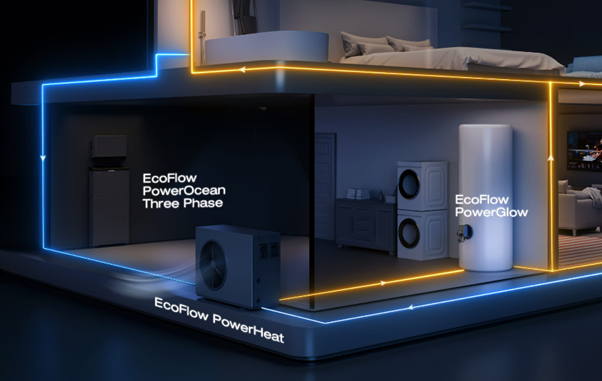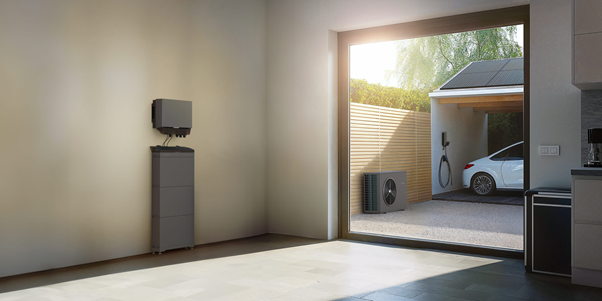How Do Heat Pumps Work?
Heat pumps are essential home systems that use electricity to warm or cool a building by transferring heat from one place to another. During warm months, the pump may move warmth from indoors to outdoors, while it may pump warmth into a building during cold winters.
Understanding the different types of heat pumps and how they work can help you determine whether the equipment is right for you. It could help you save on electricity bills and contribute toward net-zero goals in the UK.
How Does A Heat Pump Work?
There are four stages to the refrigeration cycle that a heat pump uses:
1. Evaporation
The pumps take in warmth from their source, whether the air, ground, water, or even the sun. The thermal energy then gets transferred to a heat exchanger, where liquid refrigerant is stored. The refrigerant quickly absorbs the warmth and evaporates, transforming it into a low-temperature, low-pressure gas.
2. Compression
From there, the gas moves into an electricity-powered compressor, which compresses the gaseous refrigerant, increasing its pressure and raising the temperature high enough to warm a home.
3. Condensation
The warmed and compressed gas then passes over the internal heat exchanger, where it circulates and either gets blown into the home's interior or transferred into a cold water circuit. Once the water reaches the desired temperature at the cold water circuit, it is sent to your underfloor system and radiators to warm the house.
4. Expansion
As the warmed air is transferred into the home, the gas that remains in the water circuit begins to fall in temperature, returning the refrigerant to a liquid state. The cooled refrigerant then moves through the expansion stage, during which a valve lowers the pressure, allowing it to absorb more thermal energy. At this point, it pumps back into the heat exchanger and repeats the cycle.
These four steps are the general process of a heat pump warming a home. However, depending on the type of pump used, there may be slight variations in how it works.
What Are the Different Types of Heat Pumps?
The most common types of pumps are air-source, ground-source, and water-source pumps. Hybrid and solar-assisted models are also available, but they’re less prevalent.
Air source heat pumps
An air-source heat pump, such as the EcoFlow PowerHeat Air-to-Water Heat Pump, boosts warmth to the air to a higher temperature by feeding it into a home’s wet central heating system. Air-to-air pumps feed warm air into the house through fans, so they cannot produce hot water in addition to warm air.
The air-source model is one of the most popular pumps in the UK because it is well-suited for most homes, including apartments, flats, and terraced houses.
Note that air-source pumps require electricity to run, though it’s only about 25%. They’re also great at working in low temperatures since a large air volume passes the heating exchange surface.
Ground-source heat pumps
Ground-source pumps instead use an embedded ground system to extract thermal energy, which requires ample land to allow a ground array or borehole system to be installed. Once installed, these systems are undetectable. They use a mixture of water and antifreeze and pump it through a heat exchanger inside an outbuilding or the house.
As the “brine” (antifreeze and water combination) passes through the heat exchanger, it warms the refrigerant, which continues onto the compressor to find its way into the home.
Water-source heat pumps
Pumps that extract thermal energy from water require the home to be near a body of water or a borehole system. They’re one of the most low-profile and reliable options, and they're renewable because they use water. Otherwise, they’re very similar to ground-source pumps.
Hybrid heat pumps
Hybrid pumps combine a fossil fuel boiler with a standard heat pump, creating a dual-energy system. It monitors the outside temperature, automatically selecting the most energy-efficient option to keep water hot and the home consistently comfortable.
Solar-assisted heat pumps
Another alternative is the solar-assisted pump, which uses solar panels to capture and create the thermal energy that warms the refrigerant and supports the pump.

How Do Heat Pumps Contribute to Achieving Net-Zero Goals?
Buildings and how we warm them cause more than 40% of global emissions. We can switch from high-carbon heating systems to low (or zero) carbon alternatives to reach net-zero carbon emissions goals more quickly. These pumps help us achieve this by producing more energy than they consume—up to 2-3x more output than is consumed as electricity input.
Renewable energy sources, like wind or solar, can also support these pumps to make them even cleaner. The EcoFlow PowerGlow, which turns solar power into hot water, is a perfect example.
Will Installing a Heat Pump Help Save Money on Heating Bills?
It depends on what system you’re replacing with a heat pump. If your new pump is high-efficiency, it should be a cheaper upgrade, but it may still be more expensive than a gas boiler.
Another way to save on electricity bills is to choose a pump that works with renewable energy systems. For example, integrating EcoFlow’s PowerHeat with EcoFlow’s PowerOcean Single-Phase or Three-Phase systems can lower energy costs and increase energy independence.
Is Financial Support Available for Installing a Heat Pump?
Funding options are available in England/Wales, Scotland, and Northern Ireland to help cover the installation costs of a heat pump.
- England and Wales: The Boiler Upgrade Scheme can provide up to £7,500 in grant money.
- Scotland: Through Home Energy Scotland, you may be eligible for a £7,500 loan for home renewable upgrades or a £ 7,500 grant for energy efficiency upgrades.
- Northern Ireland: Contact NI Energy Advice to discover funding options that may be available.
Frequently Asked Questions
- How Does a Heat Pump Work in Simple Terms?It uses a small amount of electricity to move warmth from one place to another, using air, water, ground, or solar power as a thermal energy source. It can also work in reverse to remove excess heat from a building and cool the interior of a home.
- How Does a Heat Pump Work in Winter?In the winter, the pump either absorbs heat from the air, water, or ground and then uses it to evaporate refrigerant, compress and warm it, condense it, and carry the new warmth into the home through the radiator or underfloor heating.

Final Thoughts
Heat pumps use energy from the environment, whether the ground, air, or water, to extract thermal energy and convert it into usable power for your home’s air and water. It uses a four-step system to heat or cool the air to the appropriate temperature and transfer it to your water pump or air ducts.
By combining pumps such as the EcoFlow PowerHeat with renewable energy storage systems like the EcoFlow PowerOcean (Three-Phase), you can create an environmentally friendly home heating and power system that integrates seamlessly.




